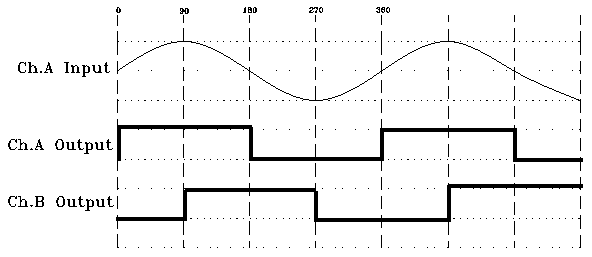The purpose of this document is to objectively present the main features and differences between the signals provided by an incremental optical encoder and an interpolated incremental optical encoder. On the first case, the number of pulses coincides with the pulses number of its associated optics, while in the interpolated case the generated number of signals is higher than its associated optics.
We take into consideration the following key points: resolution, precision and durability.
RESOLUTION
Interpolated encoder’s resolution can theoretically achieve infinite limits since the optical signal is processed by interpolation circuitry. The question is where to set up the limit, in order to get a quality signal. Our engineering department performed tests, and we can say that interpolation can get incremental signals with the same performance as a non interpolated optical encoder with a resolution over 40,000 ppr. Above this limit will depend on the computer to which the encoder is connected. In some cases, the signals with strong “duty” variations might be misinterpreted and lead to unexpected errors.
Without interpolation, an incremental optical encoder can get resolutions of 10,000 ppr, with excellent quality signals, but requires very high mechanical and optical requirements. Many of the 10,000 ppr encoders on the market are based on an interpolation x4, and some of them not even inform the market that the signals are generated in this way.
Hohner has 10,000 ppr direct reading of the disk encoders and offer up to 50,000 ppr encoders with signals generated by interpolation. Customers can choose the option according to the requirement of the application.
PRECISION
For resolutions up to 10,000 ppr, signals are achieved with similar accuracies. For higher resolution, due to the decomposition of the signal, interpolated encoders precision is lower. It causes distortions in the signals period (duty) accepted by almost all drivers and PLCs which often work with flanks rather than full pulses. If we need over 10,000 ppr resolutions should consider that the signal quality will be affected by internal and external noise. The interpolation circuit recognizes that noise as a signal, and transforms them into unwanted signals.

The accuracy of optical encoders is directly related to the quality of its optical and mechanical parts. Signal purity depends on the set up, environment and maintenance.
In a direct reading of an optical encoder of a maximum of 10,000 ppr, the mechanical set up is very critical and the environmental conditions are also very important because of the adjustment of the optical part. The electronics is very sensitive and it is strongly connected to the mechanical features, so we get signals of excellent quality but with mounting requirements to ensure the durability of this very demanding quality.
DURABILITY
Practically both types of encoders have the same life, since mostly it depends on the life of mechanical components so there are no differences.
One reason why Hohner recommends using interpolated encoders for 10,000ppr resolutions is the balance between the signal quality and improved durability. The interpolated encoders can offer a product with high resolution, excellent signal quality and higher durability expectation because the mechanical adjustments requirements are lower, so we can say that we face a more robust product with a longer durability.
According to all this information, on our interpolation electronic catalog we recommend for 10,000 ppr encoders, direct reading encoders if the application requires it.











